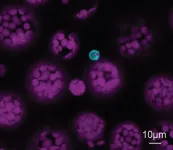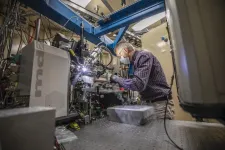(Press-News.org) PHILADELPHIA -- (Jan. 12, 2021) -- Scientists at The Wistar Institute have created an advanced humanized immune system mouse model that allows them to examine resistance to immune checkpoint blockade therapies in melanoma. It has revealed a central role for mast cells. These findings were published today in the journal Nature Communications.
Checkpoint inhibitors revolutionized therapeutic options for advanced melanoma. However, only a fraction of patients respond to this treatment and some relapse due to reemergence of therapy-resistant lesions.
"To better understand why some cancers do not respond or become resistant to checkpoint therapies, we need more preclinical models that mimic the human tumor immune environment," said Rajasekharan Somasundaram, Ph.D., a member of The Wistar Institute Melanoma Research Center, who is the first and corresponding author of the paper.
Due to critical differences in the murine and human immune systems, mouse models do not allow the study of immune mechanisms that are uniquely human. "Humanized" mouse models are widely used to mimic the human immune system in mice.
Wistar's new humanized mouse model relies upon transplanted human stem cells and tissues that have been uniquely engineered to produce combinations of human cytokines that result in a more physiologically relevant model system for evaluating new immuno-oncology therapies and effective treatments targeting the tumor microenvironment.
"Our novel humanized mouse model has a longer life span and allowed us to study treatment responses to immunotherapies after human tumor transplant," said Somasundaram, who was part of a Wistar team led by Meenhard Herlyn, D.V.M., D.Sc., professor in The Wistar Institute Cancer Center, director of The Wistar Institute Melanoma Research Center, and a co-senior author on the study.
Researchers transplanted human metastatic melanoma cell lines into their humanized mouse model and treated them with anti-PD-1 antibody therapy. By studying immune cell infiltration into the tumors, Somasundaram and colleagues observed an abundance of infiltrated mast cells in anti-PD-1-treated tumors. Mast cells are an immune cell found throughout the body, especially in the skin and mucosa, where they serve as a first line of defense against pathogens. In samples from melanoma patients receiving immune checkpoint therapies, the team saw the same higher abundance of mast cells in non-responding tumors.
The authors showed that combining anti-PD-1 therapy with small molecule inhibitors able to deplete mast cells caused complete regression of tumors in mice and prolonged survival in comparison with mice receiving either treatment. Importantly, mice that reached remission did not show any signs of recurrence for four weeks after cessation of therapy and developed memory T cell response against melanoma tumors.
"Our results suggest that mast cells are associated with resistance to anti-PD-1 therapy, and that depleting mast cells is beneficial to immune checkpoint therapy responses," said Herlyn. "This warrants further investigation into the development of new combined immunotherapy approaches with small molecule inhibitors for the treatment of melanoma patients."
INFORMATION:
Co-authors: Thomas Connelly, Robin Choi, Hyeree Choi, Anastasia Samarkina, Ling Li, Elizabeth Gregorio, Yeqing Chen, Mohamed Abdel-Mohsen, Marilda Beqiri, Meaghan Kiernan, Michela Perego, Fang Wang, Min Xiao, Denitsa Hristova, Joshua Wang, Mizuho Fukunaga-Kalabis, Clemens Krepler, Fang Ping-Chen, Xiang Y. Zhou, Alexis Gutierrez, Frederick Keeney, James Hayden, Brian J. Gavin, David Weiner, Luis J. Montaner, Qin Liu, and Dmitry Gabrilovich (now at AstraZeneca) from Wistar; Rohit Thakur, Elizabeth M. Burton, Michael A. Davies, Michael T. Tetzlaff, and Jennifer A. Wargo from MD Anderson Cancer Center, Houston, Texas; Xiaowei Xu, Alex Huang, Anthony Secreto, Gwenn Danet-Desnoyers, Daniel Traum, Klaus H. Kaestner, and Alex Huang from University of Pennsylvania; Johannes Griss from Medical University of Vienna, Vienna, Austria; Lukas Peiffer and Ju?rgen Becker from University of Duisburg-Essen, Essen, Germany.
Work supported by: National Institutes of Health (NIH) grants P50 CA174523 and U54 CA224070; Department of Defense Peer Reviewed Cancer Research Program grants WX1XWH-16-1-0119 (CA150619), W81XWH-16-1-0120 and W81XWH-16-1-0121; Additional support was provided by the University of Texas MD Anderson Cancer Center Melanoma Moon shot Program and the Dr. Miriam and Sheldon G. Adelson Medical Research Foundation. Support for The Wistar Institute facilities was provided by Cancer Center Support Grant P30 CA010815.
Publication information: "Tumor-infiltrating mast cells are associated with therapy resistance to anti-PD-1", Nature Communications (2020). Online publication.
The Wistar Institute is an international leader in biomedical research with special expertise in cancer research and vaccine development. Founded in 1892 as the first independent nonprofit biomedical research institute in the United States, Wistar has held the prestigious Cancer Center designation from the National Cancer Institute since 1972. The Institute works actively to ensure that research advances move from the laboratory to the clinic as quickly as possible. wistar.org.
Imagine you gave the exact same art pieces to two different groups of people and asked them to curate an art show. The art is radical and new. The groups never speak with one another, and they organize and plan all the installations independently. On opening night, imagine your surprise when the two art shows are nearly identical. How did these groups categorize and organize all the art the same way when they never spoke with one another?
The dominant hypothesis is that people are born with categories already in their brains, but a study from the Network Dynamics Group (NDG) at the Annenberg School for Communication has discovered a novel explanation. In an experiment in which people were asked to categorize unfamiliar shapes, individuals and small groups created ...
New research has found as climate change causes the world's oceans to warm, baby sharks are born smaller, exhausted, undernourished and into environments that are already difficult for them to survive in.
Lead author of the study Carolyn Wheeler is a PhD candidate at the ARC Centre of Excellence for Coral Reef Studies at James Cook University (Coral CoE at JCU) and the University of Massachusetts. She examined the effects of increased temperatures on the growth, development and physiological performance of epaulette sharks--an egg-laying species found only ...
COLUMBUS, Ohio - An unfortunate truth about the use of mechanical ventilation to save the lives of patients in respiratory distress is that the pressure used to inflate the lungs is likely to cause further lung damage.
In a new study, scientists identified a molecule that is produced by immune cells during mechanical ventilation to try to decrease inflammation, but isn't able to completely prevent ventilator-induced injury to the lungs.
The team is working on exploiting that natural process in pursuit of a therapy that could lower the chances for lung damage in patients on ventilators. Delivering high levels of the helpful molecule with a nanoparticle was effective ...
Abu Dhabi, United Arab Emirates, January 12, 2020: New research from NYU Abu Dhabi's Laboratory of Neural Systems and Behavior for the first time used an animal model to demonstrate how abnormal sleep architecture can be a predictor of stress vulnerability. These important findings have the potential to inform the development of sleep tests that can help identify who may be susceptible -- or resilient -- to future stress.
In the study, Abnormal Sleep Signals Vulnerability to Chronic Social Defeat Stress, which appears in the journal Frontiers in Neuroscience, NYUAD Assistant Professor of Biology Dipesh Chaudhury and Research Associate Basma Radwan describe their development of a mouse ...
ORLANDO, Fla. -- A new national survey by the Orlando Health Heart & Vascular Institute finds many Americans would delay doctor's appointments and even emergency care when COVID-19 rates are high. The survey found 67 percent of Americans are more concerned about going to medical appointments when COVID-19 rates are high in their area and nearly three in five (57 percent) are hesitant to go to the hospital even for an emergency.
In a time when every trip out of the house and every person we come in contact with poses a threat of contracting COVID-19, ...
WASHINGTON - Computer-based artificial intelligence can function more like human intelligence when programmed to use a much faster technique for learning new objects, say two neuroscientists who designed such a model that was designed to mirror human visual learning.
In the journal Frontiers in Computational Neuroscience, Maximilian Riesenhuber, PhD, professor of neuroscience, at Georgetown University Medical Center, and Joshua Rule, PhD, a postdoctoral scholar at UC Berkeley, explain how the new approach vastly improves the ability of AI software to quickly learn new visual ...
The Korea Institute of Science and Technology (KIST) has announced that the research team led by Dr. Kim Kyoung-Whan at the Center for Spintronics has proposed a new principle about spin memory devices, which are next-generation memory devices. This breakthrough presents new applicability that is different from the existing paradigm.
Conventional memory devices are classified into volatile memories, such as RAM, that can read and write data quickly, and non-volatile memories, such as hard-disk, on which data are maintained even when the power is off. In recent years, related academic and industrial fields have been combining their advantages to accelerate the development of next-generation memory that is fast and capable of maintaining data even when the power is off.
A spin memory ...
The leaf vasculature of plants plays a key role in transporting solutes from where they are made - for example from the plant cells driving photosynthesis - to where they are stored or used. Sugars and amino acids are transported from the leaves to the roots and the seeds via the conductive pathways of the phloem.
Phloem is the part of the tissue in vascular plants that comprises the sieve elements - where actual translocation takes place - and the companion cells as well as the phloem parenchyma cells. The leaf veins consist of at least seven distinct cell types, with specific roles in transport, metabolism and signalling.
Little is known about ...
A team of HIV researchers, cellular biologists, and biophysicists who banded together to support COVID-19 science determined the atomic structure of a coronavirus protein thought to help the pathogen evade and dampen response from human immune cells. The structural map - which is now published in the journal PNAS, but has been open-access for the scientific community since August - has laid the groundwork for new antiviral treatments tailored specifically to SARS-CoV-2, and enabled further investigations into how the newly emerged virus ravages the human body.
"Using X-ray crystallography, we built an ...
A new study published in the American Journal of Preventive Medicine found a 25% increase in food insufficiency during the COVID-19 pandemic. Food insufficiency, the most extreme form of food insecurity, occurs when families do not have enough food to eat. Among the nationally representative sample of 63,674 adults in the US, Black and Latino Americans had over twice the risk of food insufficiency compared to White Americans.
"People of color are disproportionately affected by both food insufficiency and COVID-19," said Jason Nagata, MD, MSc, assistant professor of pediatrics at the University of California, San Francisco and lead author on the study. "Many of these individuals have experienced job loss and higher rates of poverty during the ...




